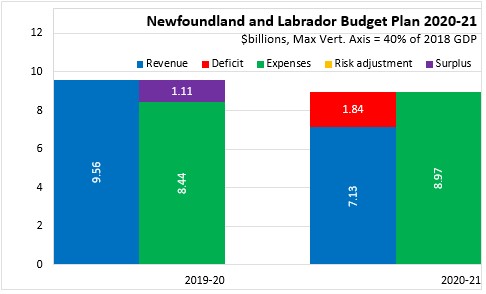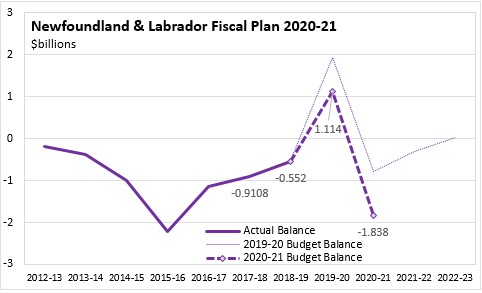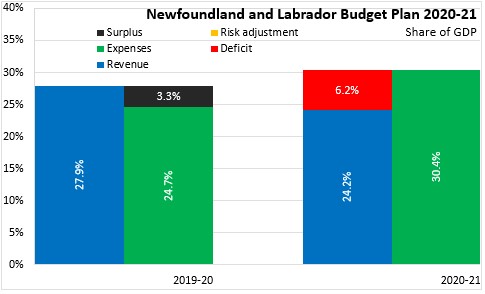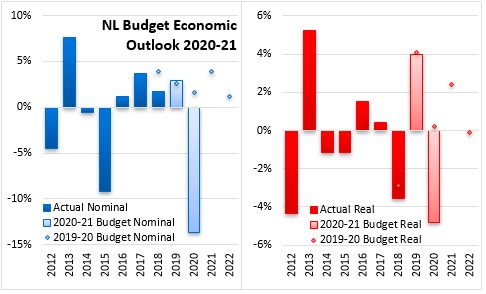The Economics and Statistics Division maintains archives of previous publications for accountability purposes, but makes no updates to keep these documents current with the latest data revisions from Statistics Canada. As a result, information in older documents may not be accurate. Please exercise caution when referring to older documents. For the latest information and historical data, please contact the individual listed to the right.
<--- Return to Archive
For additional information relating to this article, please contact:
October 01, 2020NEWFOUNDLAND AND LABRADOR BUDGET 2020-21 The Province of Newfoundland and Labrador has released its Budget for the 2020-21 fiscal year. After posting an extraordinary surplus of $1.11 billion in 2019-20 (owing to a one-time payment from the Federal government for the Atlantic Accord), the Province expects to return to a deficit of $1.838 billion. Revenues are projected to fall from $9.56 billion to $7.13 billion (-25.4 per cent) without the $2.5 billion Atlantic Accord payment. Revenues of $7.83 billion in the 2018-19 fiscal year offer a better comparison to planned revenues in 2020-21. Newfounfland and Labrador government expenditures are projected to rise from $8.44 billion in 2019-20 to $8.97 billion in 2020-21.

Prior to the COVID-19 pandemic and oil price shock of early 2020, the government of Newfoundland and Labrador had been planning on a return to balance by 2022-23. This plan was based on falling expenditures as well as rising revenues. However, because of the economic uncertainty caused by COVID-19, Newfoundland and Labrador's Budget does not include a medium term fiscal projection.
Revenues for 2019-20 have been revised down $881 million from Budget. Expenses for 2019-20 are $18 million higher than estimated in the 2019-20 Budget.
Last year's fiscal plan anticipated 2020-21 revenues of $7.46 billion and expenses of $8.24 billion. With the 2020-21 Budget, the outlook for revenues has been revised down by $333 million to $7.13 billion while the outlook for expenses has been revised up $729 million to $8.97 billion.

The extraordinary surplus in 2019-20 was originally estimated at $1.925 billion, but this has been revised down to a surplus of $1.114 billion on lower than expected revenues. For 2020-21, the previously-projected deficit of $0.796 billion has been revised to a deficit of $1.838 billion.

Newfoundland and Labrador's economy is highly sensitive to oil investment, oil production and oil prices. In 2020, lower oil prices are expected to cause the province's nominal GDP to shrink by 13.7 per cent. This sizable reduction in the value of GDP causes the 'footprint' of the provincial government relative to the economy to expand. Expenses rise from 24.7 per cent of GDP in 2019-20 to 30.4 per cent of GDP in 2020-21. Revenues fall from 27.9 per cent of GDP (including the one-time Atlantic Accord payment) to 24.2 per cent of GDP in 2020-21. The surplus of 3.3 per cent of GDP in 2019-20 changes to a deficit of 6.2 per cent of GDP in 2020-21. Newfoundland and Labrador's debt is projected to rise by $2.1 billion, reaching $16.4 billion (55.7 per cent of 2020 nominal GDP).

The shock to Newfoundland and Labrador's economy from COVID-19 has been similar to the experiences reported in other jurisdictions in 2020. Real GDP is projected to decline by 4.8 per cent while employment falls 5.8 per cent. However, in addition to COVID-19, the Newfoundland and Labrador economy is highly sensitive to conditions in the oil market. With a large decline in oil prices ($39 USD/bbl in 2020), Newfoundland and Labrador's nominal GDP is projected to decline by 13.7 per cent. Capital investment is projected to decline to less than $9 billion (-13.6 per cent) on completion of major projects at Voisey's Bay, Muskrat Falls and West White Rose. Exports are projected to decline, notably on suspension of production from the Come-By-Chance refinery.
No economic forecast is provided for 2021 and beyond. The Newfoundland and Labrador Budget's economic outlook notes that recovery is expected, but the pace of the province's economic recovery is senstive to investment activity that depends on volatile oil markets.

Key Measures and Initiatives
The government of Newfoundland and Labrador identifies four core priorities: promoting physical and mental health, growing the population, expanding technology and developing resources. The government has already announced several initiatives to manage the economic shocks of COVID-19, including deferred/waived fees, procurement thresholds that ensure competition by local business, a residential construction rebate and investment in natural resource/tourism industries. The government has also embarked on a strategic initiative to address Newfoundland and Labrador's structural issues, including higher costs of services for a large geography and an older, declining population. The 2020-21 Newfoundland and Labrador Budget also committed to $25/day child care in 2021 and the imposition of a 20 per cent tax on vaping products.
Newfoundland and Labrador Budget 2020-21
<--- Return to Archive